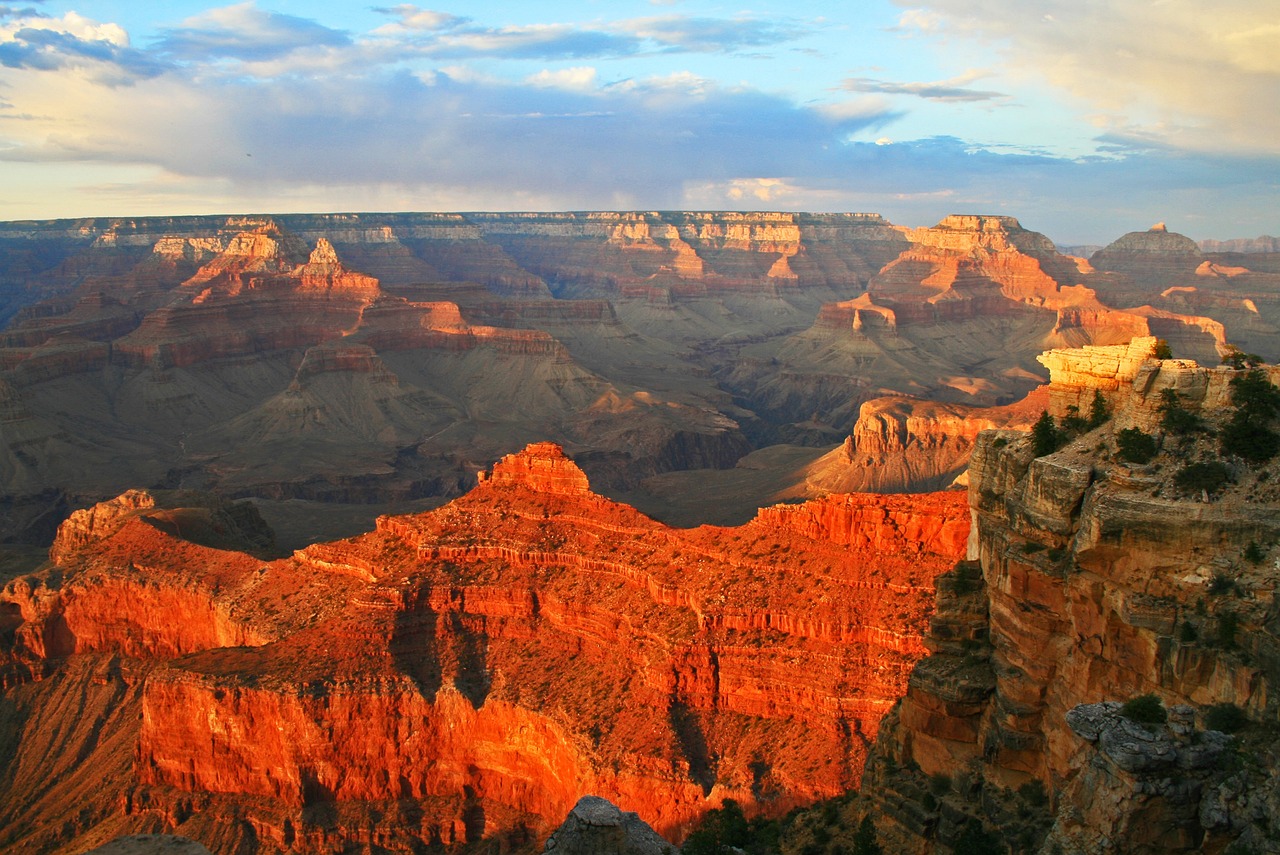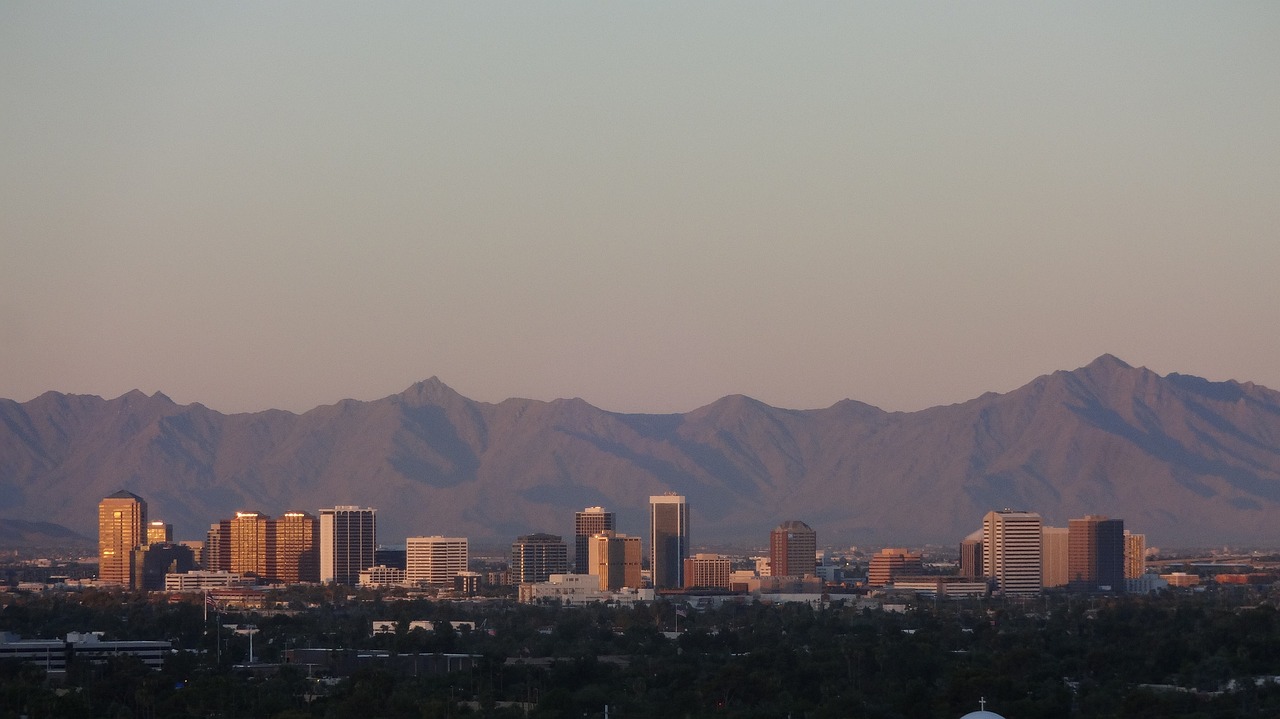
Planning a trip can be hard. The Grand Canyon National Park is one of the wonders of Arizona. This post will show you why it’s a must-see, and how to make the most of your visit. Keep reading!
Key Takeaways
- The Grand Canyon National Park has South Rim and North Rim each with unique views and activities. South Rim is open all year, North Rim from May to October.
- Visitors can do many things like hiking, river rafting, and watching wildlife. There are trails for all levels of hikers.
- The climate varies a lot. Spring and fall have the best weather for visiting.
- Staying in the park offers different options such as hotels, lodges, campgrounds, or vacation rentals.
- Supporting the park through sustainable practices helps protect it for future visitors.
Geography of Grand Canyon National Park

The Grand Canyon National Park spans across Arizona and is divided into South Rim and North Rim, both offering breathtaking views of the Colorado River and its adjacent uplands. The park’s diverse geography includes steep cliffs, plateaus, and deep canyons, providing a unique experience for visitors.
South Rim
South Rim is the most visited part of Grand Canyon National Park. It’s open all year, making it easy for travelers to plan their visit. Here, you find lots of trails and views that show off the canyon’s beauty.
This rim is famous for its lookout points like Mather Point and Yavapai Observation Station.
Getting around South Rim is simple, thanks to a free shuttle bus. The Visitor Center helps guests figure out what to see and do. For those who love taking pictures, this place offers some of the best sunrise and sunset spots in Arizona.
North Rim
The North Rim of Grand Canyon National Park stands high, offering cooler temperatures and lush forests. It’s less visited than the South Rim. This means more quiet paths for you. At over 8,000 feet in elevation, it provides unique views and experiences.
You can find trails like Bright Angel Point here. They show off wide canyon vistas that take your breath away. Lodging at the North Rim is cozy, giving a sense of being close to nature.
Remember, it’s open from May through October due to heavy snow in winter months.
Colorado River and Adjacent Uplands
Moving from the serene beauty of the North Rim, we dive into the heart of Grand Canyon National Park: the Colorado River and its adjacent uplands. The river cuts a path through Arizona, shaping the canyon for millions of years.
Its waters are vital, supporting life in this rugged landscape.
Around the river, uplands stretch out. Here, plants and animals thrive in a mix of desert and forest areas. This place shows how water creates life in dry lands. Visitors see unique geology and vibrant ecosystems side by side.
It’s where adventure meets nature’s wonders head-on.
Climate and Best Visiting Seasons
Grand Canyon National Park experiences a dry climate with hot summers and mild winters. Summer temperatures can soar to over 100°F (38°C) in the inner canyon, making it challenging for outdoor activities.
Spring and fall are ideal for visiting due to pleasant temperatures ranging from 60-80°F (15-27°C). These seasons also offer clear skies, perfect for capturing breathtaking views.
During winter, the North Rim is closed due to heavy snowfall, but the South Rim remains open, providing a unique experience of the canyon blanketed in white. To avoid crowds and make the most of your trip, plan a visit during early spring or late fall when weather conditions are comfortable and allow you to enjoy hiking trails without extreme heat or cold.
Activities and Attractions
Discover the exhilarating hiking trails, thrilling river rafting, captivating wildlife watching, and breathtaking scenic viewpoints that will make your visit to Grand Canyon National Park an unforgettable experience.
Ready for adventure? Read More About It!
Hiking Trails
The hiking trails in Grand Canyon National Park offer spectacular opportunities to explore the unique landscape and breathtaking views.
- Bright Angel Trail: This popular trail offers a variety of distance options, from short hikes to full-day excursions, with stunning canyon vistas and resting spots along the way.
- South Kaibab Trail: Known for its panoramic views, this trail takes hikers into the heart of the canyon, providing an unforgettable experience.
- Rim Trail: Perfect for casual strolls or longer day hikes, this trail runs along the South Rim, offering numerous vantage points and access to other trails.
- North Kaibab Trail: Descending into the northern part of the canyon, this trail presents diverse ecosystems and scenic beauty as it winds down to the Colorado River.
- Hermit Trail: Hikers can enjoy a more secluded experience on this challenging trail that leads to awe-inspiring overlooks and ancient geological formations.
Make sure to carry sufficient water, wear sturdy hiking shoes, and check weather conditions before embarking on any hike within the park.
River Rafting
River rafting at Grand Canyon National Park offers an exhilarating way to experience the Colorado River’s power and beauty.
Here is what you can expect:
- Thrilling rapids provide an adrenaline-pumping adventure.
- The river’s twists and turns reveal hidden alcoves and stunning geological formations.
- Rafting trips range from dory expeditions to multi-day whitewater adventures, catering to various preferences and time frames.
- Experienced guides lead the excursions, offering insights into the area’s history, geology, and wildlife.
- Opportunities for camping along the riverbank allow for a deeper connection to the canyon’s natural wonder.
These experiences make river rafting an unforgettable part of any visit to Grand Canyon National Park.
Wildlife Watching
The park is home to a diverse range of wildlife, offering great opportunities for nature enthusiasts. Here’s what you can expect while wildlife watching at Grand Canyon National Park:
- The park boasts over 400 species of birds, including bald eagles, peregrine falcons, and California condors.
- Keep an eye out for mammals such as mule deer, bighorn sheep, mountain lions, and coyotes as they roam the rugged terrain.
- Grand Canyon is also home to a variety of reptiles and amphibians, including rattlesnakes and the elusive canyon tree frog.
- Enjoy the unique flora with more than 1,700 known plant species across the park’s diverse ecosystems.
This diverse array of wildlife makes every visit to the Grand Canyon a memorable experience in nature.
Next: “Historic and Cultural Significance
Scenic Viewpoints
The Grand Canyon National Park features numerous scenic viewpoints offering breathtaking vistas of the vast canyon and its mesmerizing geological formations. Here are some must-see viewpoints at the park that offer stunning perspectives:
- Hopi Point: Provides a panoramic view of the Colorado River as it winds through the canyon, offering an ideal spot to witness the sunrise or sunset.
- Mather Point: One of the most iconic and easily accessible viewpoints, providing awe-inspiring views of the canyon’s massive expanse and colorful rock layers.
- Yavapai Point: Offers sweeping vistas and is also home to the Yavapai Geology Museum where visitors can learn about the canyon’s formation.
- Lipan Point: Known for its outstanding views of the eastern portion of the Grand Canyon, providing excellent photo opportunities.
- Desert View Watchtower: This historic stone tower offers a unique vantage point, combining ancient architecture with breathtaking views of the canyon and Colorado River.
- Moran Point: Offers uncrowded panoramic views of both upstream and downstream sections of the Colorado River, making it an excellent spot for photography enthusiasts.
- Bright Angel Point: Situated on the North Rim, this viewpoint overlooks part of Bright Angel Canyon, providing spectacular views across to Roaring Springs and Phantom Ranch.
- Shoshone Point: A secluded viewpoint accessible by permit only, offering a peaceful setting and uninterrupted views for those seeking a more serene experience.
These viewpoints provide unforgettable experiences for visitors seeking to marvel at one of nature’s most impressive creations—the Grand Canyon.
Historic and Cultural Significance
Discover the unique history of the Grand Canyon, from the Village Historic District to its deep connection to ancestral homelands. Explore how this iconic natural wonder intertwines with centuries of human culture and heritage.
Village Historic District
The Village Historic District is a place where you can explore the Native American history of the Grand Canyon. It’s home to Hopi House, designed by Mary Colter in 1905 to resemble a traditional Hopi dwelling.
You’ll find authentic Native American arts and crafts at the historic Lookout Studio.
Many buildings in this district date back to the early 20th century, offering a glimpse into the past. The Kolb Studio, for example, displays photography from Emery and Ellsworth Kolb who documented their adventures at the canyon from 1902.
It’s a great spot to learn about the rich cultural heritage that has shaped this breathtaking landscape.
Connection to Ancestral Homelands
The Village Historic District is a significant part of the Grand Canyon National Park, connecting visitors to the ancestral homelands of Native American tribes such as the Havasupai, Hualapai, Navajo, Hopi, and Zuni.
These tribes have historical ties to the land that predates the establishment of the park by thousands of years. Their cultural heritage enriches the park’s atmosphere and provides a deeper understanding of the area’s significance beyond its natural beauty.
The presence of these indigenous communities adds to the diversity and spiritual value of this iconic landmark.
The connection to ancestral homelands offers an opportunity for visitors to appreciate not only the geological marvels but also recognize and honor these long-standing relationships between Indigenous peoples and their traditional lands within Grand Canyon National Park.
Tips for Visiting
When you visit, choose the right rim for your interests and pack essentials like water and layered clothing. Capture breathtaking sunrise and sunset views at the best times for an unforgettable experience.
Choosing the Right Rim
To make the most of your visit, it’s important to choose the right rim of the Grand Canyon. The South Rim is more accessible and offers a wide range of facilities, including hotels and viewpoints.
On the other hand, the North Rim provides a quieter and more remote experience with fewer crowds. Both rims boast stunning panoramic views of the canyon, so consider factors like accessibility and atmosphere when deciding which rim to explore during your trip.
When thinking about choosing between rims at Grand Canyon National Park for your vacation or travel plans, remember that each one has its own unique appeal: The South Rim is popular and easily accessible with many amenities while the North Rim offers a quieter experience in a more secluded setting.
Both provide exceptional views, so consider what kind of experience you’re seeking before making your decision on which side to explore.
Essentials for Your Trip
When visiting Grand Canyon National Park, it’s essential to be well-prepared. Here’s what you need for a smooth and enjoyable trip:
- Appropriate Footwear: Wear sturdy walking shoes or hiking boots with good traction for exploring the trails and viewpoints.
- Water and Snacks: Carry an adequate supply of water and energy-boosting snacks to stay hydrated and fueled during your excursions.
- Sun Protection: Don’t forget sunscreen, a wide-brimmed hat, and sunglasses to shield yourself from the intense desert sun.
- Layered Clothing: Be prepared for temperature variations by wearing layers that can easily be added or removed as needed.
- Camera or Binoculars: Capture stunning views and wildlife sightings by bringing along a camera or binoculars.
- Map or Guidebook: Familiarize yourself with the park’s layout and attractions using a map or guidebook to make the most of your visit.
- First Aid Kit: Carry a basic first aid kit containing essentials like bandages, antiseptic wipes, and pain relievers for any minor mishaps along the way.
- Waste Disposal Bags: Help keep the park clean by carrying waste disposal bags to pack out any trash generated during your visit.
Best Times for Sunrise and Sunset Views
The best times to see the sunrise and sunset at Grand Canyon National Park are early morning and late afternoon. The way the sun hits the canyon walls creates stunning colors and shadows.
The South Rim is perfect for sunrise views, while the North Rim offers exceptional sunset scenery due to its elevation. During summer, sunrise occurs around 5:30 AM, while in winter, it’s closer to 7:30 AM.
For sunset, expect it around 7:30 PM in summer and as early as 5:00 PM in winter.
Visitors should note that lighting conditions can change rapidly based on weather factors like cloud cover or precipitation – checking with park rangers or visitor centers for updated information is advisable.
It’s important to position yourself about an hour before sunrise or sunset; this allows enough time to find a good viewpoint and experience the awe-inspiring natural spectacle of the Grand Canyon transition from darkness into light or vice versa.
After soaking up these breathtaking moments at sunrise or sunset, visitors can explore various activities offered within the park – from hiking trails along both rims to river rafting adventures down below.
Accommodation Options
You can choose from a variety of accommodation options such as hotels, lodges, campgrounds, and vacation rentals to suit your preferences and budget. To learn more about the lodging choices at Grand Canyon National Park, keep reading!
Hotels and Lodges
When visiting Grand Canyon National Park, consider staying in one of these accommodation options:
- Hotels and Lodges: There are several hotels and lodges conveniently located within the park, offering comfortable stays with breathtaking canyon views.
- On-Site Lodging: Enjoy the convenience of staying close to popular attractions and hiking trails by choosing from a range of lodging options available on-site.
- Amenities: Many accommodations offer amenities such as dining facilities, guided tours, and easy access to shuttle services for exploring the park.
- Varied Experiences: From historic lodges with Southwestern charm to modern hotels with upscale amenities, there’s something to suit every traveler’s preference.
- Reservation Tips: Due to high demand, it’s advisable to make reservations well in advance, especially during peak tourist seasons.
Campgrounds and Vacation Rentals
Grand Canyon National Park offers various options for accommodation, ensuring a comfortable stay during your visit. Here are some choices to consider:
- Campgrounds:
- There are several campgrounds within the park offering basic facilities like restrooms and running water.
- Popular campgrounds include Mather Campground on the South Rim and North Rim Campground which require reservations well in advance due to high demand.
- Vacation Rentals:
- If you prefer a more private setting, vacation rentals are available near the park with options ranging from cozy cabins to spacious homes.
- These rentals offer a home-like experience and are often equipped with amenities such as kitchens and outdoor spaces for relaxation.
Supporting the Park
Discover the meaningful work of the Grand Canyon Conservancy, promoting sustainable tourism practices at this iconic national park. Learn how you can contribute to preserving this natural wonder for future generations.
Read more about it in our blog!
Grand Canyon Conservancy
The Grand Canyon Conservancy is a nonprofit organization dedicated to supporting and preserving the Grand Canyon. Founded in 1932, it plays a vital role in funding conservation projects, educational programs, and initiatives aimed at protecting the park’s natural beauty.
The conservancy also operates retail shops, visitor centers, and bookstores within the park, with proceeds directly benefiting preservation efforts. By supporting the Grand Canyon Conservancy through donations or purchases from their stores or membership programs, visitors can actively contribute to maintaining this iconic American landmark for future generations.
The Grand Canyon Conservancy takes pride in promoting sustainable tourism practices that reduce environmental impact while enhancing visitor experiences. They are committed to fostering an understanding of the canyon’s ecological significance and cultural heritage through various educational programs and interpretive initiatives.
With their focus on responsible stewardship of this national treasure, the conservancy aims to ensure that travelers can continue to appreciate the grandeur of the Grand Canyon for years to come.
Sustainable Tourism Practices
To ensure the long-term protection of Grand Canyon National Park, consider these sustainable tourism practices:
- Reduce Waste: Use reusable water bottles and refuse single-use plastics.
- Respect Wildlife: Keep a safe distance from animals and refrain from feeding them.
- Stay on Trails: Help preserve the fragile ecosystem by sticking to designated paths.
- Conserve Water: Be mindful of water usage, particularly in this arid environment.
- Support Local Businesses: Patronize local shops and eateries to contribute to the community’s economy.
- Minimize Carbon Footprint: Carpool or use public transportation when exploring the area.
- Educate Yourself: Learn about the park’s history, geology, and indigenous cultures to deepen your appreciation and understanding.
These sustainable practices will help protect this natural wonder for future generations to enjoy.
Conclusion
Grand Canyon National Park is a breathtaking destination with its stunning canyons and diverse landscapes. Visitors can explore the South Rim, North Rim, or enjoy the beauty of the Colorado River and adjacent uplands.
The park offers a range of activities including hiking trails, river rafting, and wildlife watching. It’s also rich in historic and cultural significance, from the Village Historic District to its connection to ancestral homelands.
When planning a visit, consider essential tips such as choosing the right rim and timing your trip for sunrise and sunset views. Accommodation options vary from hotels and lodges to campgrounds and vacation rentals.
Supporting sustainable tourism practices is crucial for preserving this natural wonder; organizations like Grand Canyon Conservancy play a key role in this regard.
In conclusion, visiting Grand Canyon National Park promises an unforgettable experience filled with natural marvels, history, adventure activities, and opportunities to support conservation efforts.
FAQs
1. What is Grand Canyon National Park?
Grand Canyon National Park is a stunning natural wonder located in Arizona. It features deep canyons, colorful rock layers, and breathtaking views that attract millions of visitors each year.
2. How do I get to the Grand Canyon?
You can reach the Grand Canyon by car, bus, or even by plane to nearby airports. The park has several entrances, with the South Rim being the most popular for its easy access and many viewpoints.
3. What activities can I enjoy at the Grand Canyon?
At the Grand Canyon, you can hike along scenic trails, take guided tours, go camping under the stars, or simply enjoy photography at various lookout points. There’s something for everyone!
4. When is the best time to visit?
The best time to visit Grand Canyon National Park is during spring or fall when temperatures are mild and crowds are smaller. Summer brings heat and more visitors while winter offers a quieter experience with beautiful snow-covered landscapes.







Leave a Reply